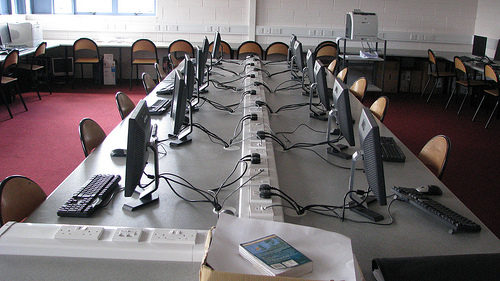That anecdote sets the tone for much of the article, which states that online learning opens opportunities for some students to take classes they wouldn't otherwise be able to, then immediately detracts its value.
"But critics say online education is really driven by a desire to spend less on teachers and buildings, especially as state and local budget crises force deep cuts to education. They note that there is no sound research showing that online courses at the K-12 level are comparable to face-to-face learning."
But there are some important questions unanswered -- and worse, they're not even asked. If students are not excelling in face-to-face settings, can online learning provide them with a better -- or different, or another -- opportunity? And can online learning open new doors that just aren't possible in a classroom, with access to different types of creative and collaborative possibilities with students and teachers worldwide? What about reports that show the value of blended learning?
The article also suggests that arguments for and against online education break down into what looks like questions of labor rather than questions of learning.
"Like other education debates, this one divides along ideological lines. K-12 online learning is championed by conservative-leaning policy groups that favor broadening school choice, including Jeb Bush’s Foundation for Excellence in Education, which has called on states to provide all students with 'Internet access devices' and remove bans on for-profit virtual schools. Teachers’ unions and others say much of the push for online courses, like vouchers and charter schools, is intended to channel taxpayers’ money into the private sector."
The political backdrop with budget issues and teacher layoffs does make this a complicated issue, but it isn't one that falls so neatly into two ideological camps. The question of the quality of online learning took center-stage in the Room for Debate section, where five educators responded about the potential and the quality of online learning at the K-12 level. Those responses show that it isn't an either-or matter here. Online isn't de facto better or worse. It isn't a matter of either public schools or private companies leading the charge.
This isn't to say, of course, we shouldn't ask tough questions about the quality of education. We need to do that for online and offline instruction. As Gary Stager writes in his Room for Debate response:
"Online environments focused on collaboration and action, rather than reading and test-taking, can be more social, creative, substantial and personally meaningful than traditional classes. Learning is no longer bound by artificial schedules, random teacher assignments or age segregation. Students feel more connected than in “school” where talking is the No. 1 infraction and teacher access is severely curtailed. When work is public, peers learn from it and support reciprocal growth. Everyone is a teacher and learner all of the time. The quality of work benefits from the extra time, collaboration and expertise.
The computer’s real power lies in how it allows kids to learn and do new things in new ways unimaginable just a few years ago. Done well, online learning could supplement classroom instruction, offer experiences otherwise impossible, support 24/7 learning and break down barriers of geography, wealth or culture.
Yes, in some cases, online learning may turn into copying from Wikipedia. But the same tactic -- plagiarism -- has been used by cheaters long before Wikipedia ever entered the scene.
Online learning does not just offer courses to K-12 students; it opens up learning options -- and that's the promise of technology.


